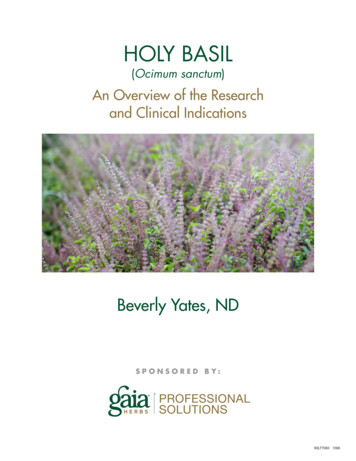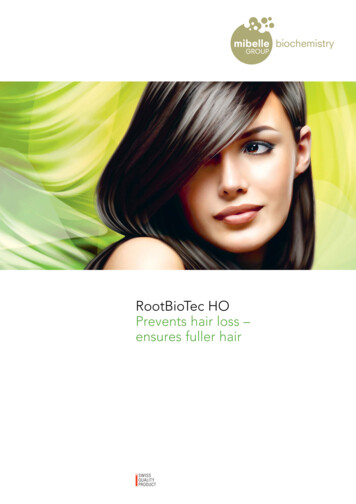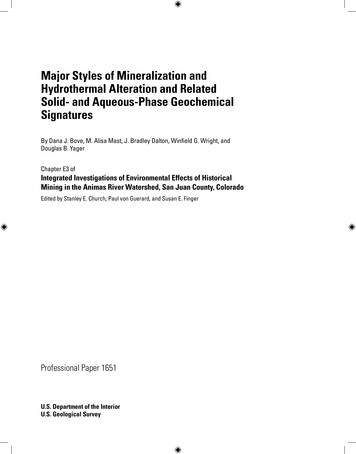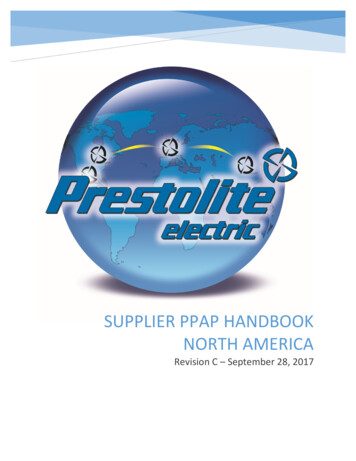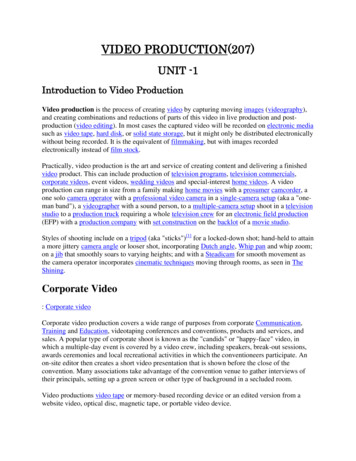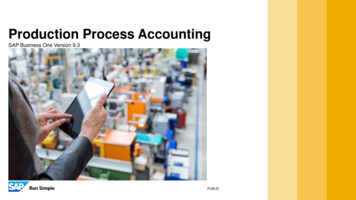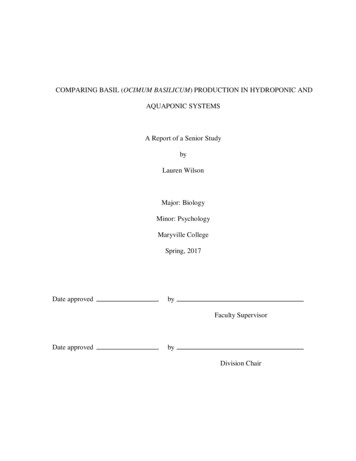
Transcription
COMPARING BASIL (OCIMUM BASILICUM) PRODUCTION IN HYDROPONIC ANDAQUAPONIC SYSTEMSA Report of a Senior StudybyLauren WilsonMajor: BiologyMinor: PsychologyMaryville CollegeSpring, 2017Date approved,byFaculty SupervisorDate approved,byDivision Chair
ABSTRACTSoilless farming, though it has been around for over two millennia, is becoming moreprevalent in modern food production as it not only saves water and space but also provides aneffective option for indoor urban farming. There are currently two major models of soillessfarming—hydroponics and aquaponics. While both systems are effective methods of soillessfarming, very few studies compare the two systems. The objective of this study was tocompare the water quality, basil (Ocimum basilicum) productivity, and basil essential oilprofiles from plants grown in a hydroponic and newly established aquaponic system. Basilplants from two age groups (young plants and old plants) were measured before, during, andafter a four-week growth period in either a hydroponic or aquaponic system. Water qualitywas also analyzed before, during, and after the growth period, and essential oils wereevaluated from harvested basil. Whereas older aquaponics plants seemed to grow betterinitially (p 0.0002 for leaf number and p 0.0036 for leaf density), at the end of the growthperiod it was younger hydroponic plants that had increased leaf number (p 0.0013) and stemheight (p 0.0041). Both water quality and essential oils differed between the systems aswell, with the aquaponics system having more stable nutrient supply and lowerconcentrations of essential oils. These data show that basil productivity is not consistentlydifferent between the two systems, but nutrient consistency and basil essential oil profilesdiffer in the two systems.iii
ACKNOWLEDGEMENTSThis project would not have been possible without the invaluable support and guidance of notonly the Maryville College community but countless others. I would first like to thank DianeKim at University of Southern California for first introducing me to aquaponics and forsparking a passion to learn more. I would also like to thank both Arielle Dolan for drawingthe beautiful graphics used in Figure 1 and Claire Snyder for her unwavering assistancethroughout all stages of the project. A huge thank you goes to Kent Davis and MariaLaughlin at Special Growers for providing a grow space and the hydroponic systems used.In addition, I would like to acknowledge the following individuals for their contributions tothe study: Bruce Guilliame with the Coyote Fund for providing additional funding, AdamLatham from the MC Steam plant for construction of the aquaponics structure, Dave Flynnfrom Perennial Ponds for providing koi, and Mike Goodrich from Cornerstone Analytics forchemical analyses. A special thanks goes to James Spalvins at Innovative Garden andHydroponic Supply for continued support and guidance regarding building and establishing ahydroponic system. I also have immense gratitude towards Dr. Nathan Duncan for providinghis chemical expertise and aiding in chemical processes and analyses, which allowed thisproject to evolve into something even bigger than I had ever expected. Last but certainly notleast, I would like to thank Dr. Drew Crain for his constant support, encouragement, andpatience. His thoughtful counsel and determination to push me outside of my comfort zonewas what truly allowed this project to succeed.iv
TABLE OF CONTENTSPageList of TablesviList of FiguresviiChapter IIntroduction1Chapter IIMaterials and Methods16Chapter IIIResults21Chapter IVDiscussion27Appendices31Works Cited46v
LIST OF TABLESTablePage1.Common plant types grown in hydroponic and aquaponic systems.2-52.Common fish species raised in aquaponic systems.10-113.Measurements (mean standard error) of leaf number, stem height 24vi
LIST OF FIGURESFigurePage1.Nitrogen cycling in aquaponic systems142.(A) The hydroponic set-up at Special Growers in Maryville, TN173.(A) Hydroponic and (B) aquaponic system designs.204.Comparison of anions (A) and cations (B) measured in water samples 225.Aphid damage in an aquaponics basil plant.236.Significant differences in mean plant measurements of basil grown 257.Chromatogram of volatile basil extract from both aquaponics and 26vii
CHAPTER IINTRODUCTIONWorld population growth is increasing rapidly at a rate which the amount ofagricultural land available for food production cannot match, resulting in an increasing needfor alternative methods of food production (de Carvalho et al. 2015). While various methodsof soilless farming have been used from the time of early civilizations, the hydroponicmethod of farming has been in modern food production for just decades, and the modernclosed-loop aquaponic system was first described in only 1984 (Elia et al. 2014; Schafer2014). Both types of systems allow for a wide variety of plants to be grown (the mostpopular of which are shown in Table 1) and so are adaptable to many different diets andcultures. While both of these methods have proven to be successful methods of horticulture,aquaponic systems are more complicated and require additional planning, materials, andtime. However, once aquaponic systems are set up and running properly, they require bothless input and less maintenance.1
Table 1: Common plant types grown in hydroponic and aquaponic systems. RT Range of growing temperatures; OT Optimalgrowing temperaturePlantCommentsReferencesLow to medium nutritional requirements; well adapted to aquaponic systemsOften grown using aquaponicsRecommended because of its quick growth, adaptability, and various usesBasil (Ocimum basilicum)Mint(Mentha spp.)Peppermint(M. piperita)Spearmint(M. spicata)pH: 5.5-6.5Temp Range: 18-30 COptimal Temp: 20-25 CSpacing: 15-25 cmLight Exposure: sunny or slightly shelteredGrowth Time: 5-6 weeksOften grown using aquaponicsRecommended because of their quick growth, adaptability, and various usesLow to medium nutritional requirements; well adapted to aquaponic systemsChives (Allium schoenoprasum)Lettuce (Lactuca sativa)Often grown using aquaponicsCommonly grown in larger scale hydroponicsThe most commonly grown species in aquaponicsDiver, 2006Elia et al., 2014Moya et al., 2014Somerville, Cohen,Pantanella, Stankus, &Lovatelli, 2014Elia et al., 2014Moya et al., 2014Diver, 2006Elia et al., 2014de Carvalho et al., 2015Elia et al., 2014Somerville et al., 20142
Lettuce (Lactuca sativa) (cont.)pH: 6.0-7.0Temp Range: 15-22 CSpacing: 18-30 cmLight Exposure: full sun (light shading in full temperatures)Growth Time: 24-32 daysde Carvalho et al., 2015Elia et al., 2014Somerville et al., 2014Spinach (Spinacia oleracea)Low to medium nutritional requirements; well adapted to aquaponic systemsDiver, 2006Often grown using aquaponicsParsley (Petroselinum crispum)Cucumber (Cucumis sativus)Tomato (Solanum lycopersicum)pH: 6.0-7.0Temp Range: 15-25 CSpacing: 15-30 cmLight Exposure: full sun, partial shade at 25 CGrowth Time: 20-30 days after transplantHave been grown using aquaponics, but is not as popular as there is a higherpayoff in growing leafy greensHave been grown using hydroponicsHigher nutritional demand; perform better in a heavily stocked, wellestablished aquaponic systempH: 5.5-6.5Temp Range: 22-28 C day, 18-20 C nightSpacing: 30-60 cmLight Exposure: full sunGrowth Time: 55-65 daysHigher nutritional demand; perform better in a heavily stocked, wellestablished aquaponic systemHave been grown using aquaponics, but is not as popular as there is a higherpayoff in growing leafy greensElia et al., 2014Somerville et al., 2014Elia et al., 2014Lazar, Lacatusu, & Rizea,2015Diver, 2006Somerville et al., 2014Diver, 2006Elia et al., 2014Somerville et al., 20143
Tomato (Solanum lycopersicum)(cont.)Peppers(Capsicumannuum)pH: 5.5-6.5Temp Range: 22–26 C day, 13–16 C nightSpacing: 40–60 cmLight Exposure: full sunGrowth Time: 50–70 days until first harvestBell PepperHigher nutritional demand; perform better in a heavily stocked, wellestablished aquaponic systemChili PepperpH: 5.5-6.5Temp Range: 22–30 C day, 14–16 C nightSpacing: 30-60 cmLight Exposure: full sunGrowth Time: 60-95 daysCauliflower (Brassica oleraceavar. botrytis)Eggplant (Solanum melongena)Beans and peas (family Fabaceae)pH: 6.0-6.5Temp Range: 20–25 C for initial vegetative growth, 10–15 C for head settingSpacing: 45–60 cmLight Exposure: full sunGrowth Time: 2–3 months (spring), 3–4 months (autumn)Have been grown using aquaponics, but is not as popular as there is a higherpayoff in growing leafy greenspH: 5.5-7.0Temp Range: 22–26 C day, 15–18 C nightSpacing: 40–60 cmLight Exposure: full sunGrowth Time: 90–120 dayspH: 5.5-70Temp Range: 22–26 C day, 16–18 C night,Spacing: 10–30 cm dependent on varietyLight Exposure: full sunGrowth Time: 50–110 daysDiver, 2006Elia et al., 2014Somerville et al., 2014Diver, 2006Somerville et al., 2014Somerville et al., 2014Elia et al., 2014Somerville et al., 2014Somerville et al., 20144
Have been grown using aquaponics, but is not as popular as there is a higherpayoff in growing leafy greensCabbage (Brassica oleracea var.capitate)Broccoli (Brassica oleracea var.italic)pH: 6.0-7.2Temp Range: 15–20 CSpacing: 60–80 cmLight Exposure: full sunGrowth Time: 45–70 days from transplantingpH: 6.0-7.0Temp Range: 13–18 CSpacing: 40–70 cmLight Exposure: full sun; can tolerate partial shade but will mature slowlyGrowth Time: 60–100 days from transplantElia et al., 2014Somerville et al., 2014Somerville et al., 2014s5
HydroponicsHydroponic farming is a form of soilless horticulture based on the foundation ofdelivering nutrients directly to plants without soil, in which soil is replaced by nutrient-richwater (Giurgiu et al. 2014; Schafer 2014). This water contains mineral elements that arenecessary for plants to grow and are directly or indirectly obtained from the soil, such asnitrogen, calcium, potassium, sodium, magnesium, and iron (de Carvalho et al. 2015; Lazaret al. 2015). Hydroponics as an agricultural method has been utilized since ancientcivilizations: records from ancient Mesopotamia, Egypt, and Rome indicate cultivation ofplants using water rather than soil, and Aztecs were known to use floating barges to farmbecause of a lack of agricultural space (Schafer 2014).Hydroponic systems vary in the way nutrients are delivered to the plants. Generally,seeds are planted in a substrate; this can be inorganic, such as river stone, rock wool, perlite,vermiculite, gravel, or clay pebbles, or organic, such as coconut fibers, peat moss, orcocopeat (Roosta and Afsharipoor 2012; Giurgiu et al. 2014; Moya et al. 2014; Schafer 2014;Lazar et al. 2015). In some systems, plants are removed from the substrate once rootsemerge and the roots are suspended directly into the aqueous solutions, while in others theseedlings may be kept in the substrate with various methods of delivering nutrients (Schafer2014). These methods include systematically spraying or washing the roots with the aqueoussolution, or irrigating the solution through porous substrate, among others (Roosta andAfsharipoor 2012; Schafer 2014).6
AquaponicsThe basic concept of aquaponics, using fish waste to fertilize plants, has been aroundfor thousands of years, with applications in early Asian and South American civilizations. Itwas not until the 1970s, however, that academic institutions began research that lead to theevolution of this basic idea into modern day food production systems, which are closed-loopsand involve optimal plant-fish ratios (Somerville et al. 2014). The first article describing amodern aquaponic systems was published in 1984 by Watten and Busch, leading to anincrease in interest and awareness among researchers for the new way of farming. It isanother form of soilless horticulture which combines the practices of hydroponics, growingplants for consumption in nutrient-supplemented water, and aquaculture, rearing fish in acontrolled environment for consumption (Tomlinson 2015). The basis of this system is thatthe waste from the fish provides nutrients needed by the plants, and the plants act as biofilters and maintain a clean environment for the fish (Elia et al. 2014; Moya et al. 2014;Tomlinson 2015).One of the most critical macronutrients required for vegetative growth is nitrogen,and fish waste contains ammonia (NH3) which, though toxic to fish in high concentrations,can be converted into nitrite (NO2) by nitrifying bacteria. The nitrite can then be convertedby a second type of nitrifying bacteria into nitrate (NO3), which is easily absorbed by plants(Tomlinson 2015). The water then becomes filtered and clean of any waste for the fish, andthe plants get nutrients they need to grow. This creates what is known as a closed-loopsystem: water is re-circulated from plants to fish and the waste from one component of thesystem becomes a resource for another part, and vice-versa (Moya et al. 2014; Tomlinson2015).7
Aquaponic systems are more complex than hydroponic systems and therefore havemore factors to consider when setting them up. An aquaponics system is essentially threemajor groups of organisms—plants, fish, and bacteria—integrating into one completeecosystem (Somerville et al. 2014). This requires a balance of conditions to make an optimalenvironment for each group. For instance, water conditions must be ideal for both plantspecies and fish species as well as for both types of bacteria, requiring a balance oftemperature, pH, and oxygen levels (Diver 2006). Another example might be the ratio ofplants to fish, which must be calculated according to a number of factors including the areaof fish habitat available, the species of fish and their ideal density, the target amount ofvegetables to harvest, the nutritional requirements of the plants, and the amount of growspace. Though the setup of aquaponics is much more intricate and requires more planningthan that of hydroponics, once established the system requires little maintenance and input.FishOne of the benefits of an aquaponic system is the wide diversity of fish that may beraised and harvested. While virtually any fish species may be used as a source of ammonia,there are a number of common species that have proven to do well in both backyard andcommercial aquaponics (Table 2). Tilapia is often cited as the most commonly raised fish incommercial systems, as the fish can be harvested for meat, have a fast growth rate, are easyto breed, and are hardy against parasites, pathogens, and stress (Elia et al. 2014; Moya et al.2014; Somerville et al. 2014).Once introduced into the aquaponic system, fish need only a source of food and dailymonitoring for illness. Pelleted fish feed is often recommend in aquaponic systems, thoughcare must be taken to ensure the fish are getting the needed amount of protein. Omnivorous8
fish, including tilapia and carp, need about 25-35% protein in their diet, and carnivorous fishneed as much as 45% protein for optimal growth (Somerville et al. 2014).9
Table 2: Common fish species raised in aquaponic systemsFishTilapia(Oreochromisspp.)CommentsBlue tilapia(Oreochromisaureus)Adapted to recirculating aquaculture systems; used in most North Americancommercial systemsNile tilapia(Oreochromisniloticus)Most common fish used in commercial aquaponicsMozambique tilapia(Oreochromismossambicus)Ideal Temp: 27-30 CTime to Maturity: 6 monthsDiet: both plant- and animal-based feedResistant to pathogens, parasites, and handling stressEasy to breed in small-scale and medium-scale aquaponic systemsCan be aggressive, particularly in low densitiesReferencesDiver, 2006Elia et al., 2014Somerville et al., 2014Common carp(Cyprinus carpio)Has been used in aquaponicsCarp(familyCyprinidae)1Silver carp(Hypophthalmichthysmolitrix)Survivable Temp Range: 4-34 CGrass carp(Ctenopharyngodonidella)Ideal Temp: 25-30 CTime to Maturity: 10 monthsDiet: manufactured pelletsElia et al., 2014Somerville et al., 201410
Catfish(orderSiluriformes)Channel catfish(Ictalurus punctatus)Has been used in aquaponicsAfrican catfish(Clarias gariepinus)Ideal Temp: 26 C (growth stops below 20-22 C)Diet: pellet feedExtremely hardy: tolerate variation in dissolved oxygen, temperature, and pH;resistant to many diseases and parasitesEasily stocked at high densities up to 150 kg/m 3Elia et al., 2014Somerville et al., 2014Adapted to recirculating aquaculture systemsRainbow trout(Oncorhynchus mykiss)Largemouth bass(Micropterus salmoides)Largemouth bass(Micropterus salmoides) (cont.)Giant river prawn(Macrobrachium rosenbergii)Has been used in aquaponicsIdeal Temp: 10-18 C; 15 C optimalDiet: high-proteinHigh tolerance to salinityAdapted to recirculating aquaculture systemsDiver, 2006Elia et al., 2014Somerville et al., 2014Has been used in aquaponicsIdeal Temp: 24-30 CSurvivable Temp Range: 10-36 CDiet: high-proteinTolerate low pH and dissolved oxygen concentrationsIdeal Temp: 24-31 CTime to Maturity: 4 monthsConsume uneaten fish food, fish waste, and miscellaneous organic material nearbottom of tankHelp clean and support system health, and accelerate organic materialdecompositionBest to combine with mid-water fish—cannot be grown in high enough densitiesto produce adequate wastes for the plantsDiver, 2006Elia et al., 2014Somerville et al., 2014Somerville et al., 20141: This family includes ornamental fish such as goldfish (Carassius auratus) and koi (Cyprinus carpio haematopterus) that are oftenused in aquaponics. They were not presented with the other species as the ideal conditions and growth rates were focused on fishraised for the food market (Somerville et al. 2014)11
NitrificationNitrogen is a macronutrient necessary for vegetative growth; indeed, it is consideredthe most important inorganic nutrient needed by plants (Somerville et al. 2014). Not only isnitrogen a building block of DNA, it also composes amine functional groups, which make upamino acids (Meselson and Stahl 1958; Somerville et al. 2014). Amino acids are then usedto create proteins, which are fundamental in processes such as enzyme regulation, cellsignaling, and building cell structures (Somerville et al. 2014).Nitrogen fixation is the process of making atmospheric nitrogen available for plants,and this is a critical step in aquaponics systems (Somerville et al. 2014). In nature, nitrogenfixation occurs as part of the nitrogen cycle as a way to take forms of nitrogen that are“unusable”, such as atmospheric nitrogen (N2), and through a series of chemical reactionsconvert them into compounds that are easily absorbed by plants (Somerville et al. 2014). Inaquaponics, toxic ammonia (NH3) from fish waste must be converted into something easilyabsorbed by plant roots—nitrate (NO3-). This is achieved by two genera of nitrifyingbacteria, Nitrosomonas and Nitrobacter1 (Anthonisen et al. 1976). Removing ammonia fromthe fish environment is important as excessive ammonia in aquatic systems can causenegative effects such as extensive tissue damage in gills and kidneys, impaired growth,decreased resistance to disease, and even death (Blidariu and Grozea 2011).1Not all ammonia-oxidizing bacteria (AOB) are of the Nitrosomonas genus and not all nitrite-oxidizing bacteria(NOB) are of the Nitrobacter genus—these are simply the most frequent genera identified in each group andtherefore they are the ones generally referenced (Somerville et al. 2014). Some other genera of AOB includeNitrosococcus and Nitrosospira; some other genera of NOB include Nitrospina, Nitrococcus, and Nitrospira(AWWA 2002).12
The first step of nitrification is to oxidize ammonia into nitrite (NO2-) and is done byammonia-oxidizing bacteria (AOB), or Nitrosomonas (Equation 1) (AWWA 2002;Somerville et al. 2014). While nitrite is not as harmful to the fish as ammonia, it is still notdesirable as it can attach to hemoglobin, resulting in metehemoglobine which cannottransport oxygen (Blidariu and Grozea 2011). Therefore, the second step is to oxidize thatnitrite into nitrate, which is more readily consumed by plant roots, via nitrite-oxidizingbacteria (NOB), or Nitrobacter (Equation 2) (AWWA 2002; Somerville et al. 2014). Theentire process occurs accordingly:(1) AOB: 𝑁𝐻3 𝑂2 𝑁𝑂2 3𝐻 2𝑒 (2) NOB: 𝑁𝑂2 𝐻2 𝑂 𝑁𝑂3 2𝐻 2𝑒 This nitrification process, as illustrated in Figure 1, results in a clean environmentfree from toxic ammonia for the fish, nutrients for the plants, and a recirculating system ableto reuse water, thus drastically reducing the amount of water needed.13
Figure 1: Nitrogen cycling in aquaponic systemsIn contrast, hydroponics, while indeed reducing the amount of water traditionallyneeded, also requires the water in the reservoir to be changed periodically. Aquaponics istherefore a more sustainable practice when considering water consumption, and also has theadded benefit of the potential to harvest fish. Once set up, aquaponic systems have thepotential to produce a substantial amount of produce with little input and upkeep, whichcould affect modern approaches to soilless farming and food shortages.Research QuestionDue to increased interest in aquaponics farming, basic research comparing aquaponicsand hydroponics systems is warranted (Love et al., 2014). The objectives of this project are tocompare: (1) water profiles in aquaponics and hydroponic systems over time, (2) harvest yieldsin both aquaponic and hydroponic systems to determine if the added complexity of anaquaponic system is justified and (3) essential oil composition of basil in both systems.Because it is expected that aquaponics nutrient profiles will be less variable compared to14
hydroponics water nutrient profiles, it is hypothesized that basil yield will be higher in theaquaponics system and that essential oil composition will differ.15
CHAPTER IIMATERIALS AND METHODSEnvironmentThis study was conducted at a Special Growers greenhouse located in Maryville,Tennessee. The facility contained 3 functioning hydroponic systems at the start of the studyand was the site at which the aquaponic system was built. The established hydroponicsystems are comprised of a series of lateral grow beds connected to one of three water basinssituated beneath them (Figure 2a). These grow beds are raised on one end to allow water toflow through. Nutrient-supplemented water is pumped from the water basin to the higherend of the grow bed, where it is then pulled through the bed (and so, through the rootsystems) to the lower end and drained back into the basin. Nutrients in the water were keptat 1000 100 ppm parts per million (ppm), with equal parts of General HydroponicsFloraMicro, FloraGro, and FloraBloom.Aquaponic Construction and CyclingThe aquaponic system was constructed following the instructions on pages 21-25 of“The IBC of Aquaponics” (2011). The media for the grow bed was Sunleaves Rocks (seeFigure 2b). Once the system was fully constructed, water was added and left running withfor two days to allow the chlorine from the tap water to evaporate.16
ABFigure 2: (A) The hydroponic set-up at Special Growers in Maryville, TN. (B) Aquaponic systemwith grow bed overlaying fish chamber.17
Once the water had been dechlorinated, the instructions in AquaCycle AquaponicsCycling Kit were followed to begin system cycling (“cycling” refers to the nitrogen cyclingfrom ammonia to nitrites and nitrites to nitrates through bacteria). The instructions werefollowed assuming the tank held 250 gallons; therefore, 1.25 teaspoons (equating about 6.25g) of ammonia and 125 ml of bacteria were added to the system on Day 1 of cycling. Systemlevels (pH, temperature, ammonia, nitrite, nitrate) were tested using API Freshwater MasterTest Kit and were recorded every day until the system became “established” (i.e. there weremeasurable amounts of nitrates as well as close to no ammonia or nitrites). pH wasmaintained at 6.8 – 7.2 (up to 7.8 if no plants), and bacteria were added on days 1, 3, and 16.Once the system had measurable levels of nitrates and levels of ammonia and nitriteswere zero, 6 koi ranging from 20-50 cm in size were added to the system. Koi were obtainedfrom Perennial Ponds in Maryville, Tn and allowed to acclimate for 3 hours beforeintroducing basil plants to the grow beds (see Appendix 1 for IACUC approval).Experimental DesignThe basil plants were divided into four treatments (n 12 for each treatment) basedon system type (hydroponics or aquaponics, determined by random selection) and age whenadded to its respective system: 4 weeks old “young” plants or at 6 weeks old “old” plants.The plants in the aquaponic grow bed were arranged in a 6 x 4 grid spaced 20.32 cm apart inboth x and y planes, whereas those in the hydroponic grow beds were placed single file 20.32cm apart, with 20.32 cm in between each grow bed in order to have equal growing space ineach system (see Figure 3A-B). Plants were numbered as they were entered into theirrespective systems for identification. Plants #1-12 were young plants, and plants #13-24 were18
old plants. Each basil plant was measured for stem length and number of leaves after beingplanted in the grow bed. Stem length was measured as distance between the shoot apicalmeristem and the top of the media bed.The aquaponics and hydroponics systems were arranged juxtapose to each other inthe same greenhouse located in Maryville , Tn at Special Growers to minimize externalconfounding influences. pH was kept slightly higher at 6.8 – 7.2 in the aquaponic systemrather than at the 5.9 – 6.2 range of the hydroponic system as the former must appease notonly the plants but also the fish and bacteria.Plants were allowed to grow for 4 weeks. For water analyses, 4 ml samples fromeach system were taken over the growing period (Days 11, 17, 24, 28) in addition to 1 sampletaken before plants (and fish in the aquaponic system) were added. Samples were analyzedwith ion chromatography (see Appendix IV).At the 2-week and 4-week intervals, each plant was measured for stem length andnumber of leaves. After measurements were taken at the 4-week interval, 2 leaves were takenfrom each “old” plant for essential oil analysis.Essential oil analysis was conducted by gas chromatography-mass spectrometry(GCMS). Briefly, collected leaves were minced and extracted with anhydrous diethyl etherfor three days. Leaves were removed by a filter. The extract was dried using anhydrousmagnesium sulfate and evaporated under reduced pressure using a rotary evaporator. Thetotal extract weight was recorded and diluted to 10 mg/ml. One ml extracts were analyzed byGCMS by Cornerstone Analytics (Maryville, TN) using an Agilent 6890 GC with a 5972 MS(temperature program 40-300 C with a 60 min run at 2 microliter injection volume).19
A. HydroponicB. AquaponicFigure 3: (A) Hydroponic and (B) aquaponic system designs.Numbers indicate the ID of the plant.Statistical AnalysisLeaf density was calculated as (number of leaves/stem height). A t-test assumingequal variance (with α 0.05) was performed for each measurement (number of leaves, stemheight, and leaf density) to determine meaningful differences between each treatment.20
CHAPTER IIIRESULTSWater Quality AnalysisAnalysis of the water quality in each system revealed differences in the ioncomposition of water both between systems and over time (Figure 4, Appendix II, AppendixIII). In the aquaponics system, levels of ammonium and nitrite are initially higher, but overtime those levels decrease and levels of nitrate are seen to increase. In addition, the levels ofaquaponic anions appear to be considerably more stable over time than those of hydroponicanions. Cations in both systems appear to be fairly consistent over time.Plant MorphometricsOf the 12 comparisons made between measurements of plants in aquaponic andhydroponic systems, 4 were found to be significant (Table 3, Figure 5). The values that werefound to be significant included: number of leaves in young plants measured at 4 weeks,number of leaves in old plants measured at 2 weeks, stem length in young plants measured at4 weeks, and leaf density in old plants measured at 2 weeks. Of these variations in meanmeasurements, 2 of the 4 favored aquaponic systems (number of leaves and leaf density ofold plants measured at 2 weeks) and the other 2 of the 4 favored hydroponic systems (numberof leaves and stem length in young plants 4 weeks). By 2 weeks, basil plants in theaquaponics system had more aphids and aphid damage compared to the hydroponics system21
(an example is shown in Figure 6). All other visible parameters, including leaf color,appeared the same.Figure 4: Comparison of anions (A) and cations (B) measured in water samples taken from ahydroponic and an aquaponic growing system on Day 28. Each peak depicts a different ion.Appendix III contains an example of a complete ion chromatography result sheet.22
1002 Weeks04 Weeks*120Mean Stem Length(young)B60402 Weeks*C1008060Aquaponics40Hydroponics2002 Weeks4 Weeks*Mean Leaf Density(old)Mean Number ofLeaves (young)5080Mean Number ofLeaves (old)A604 Weeks0.70.60.50.40.30.20.10DAquaponicsHydroponics2 Weeks*4 WeeksFigure 5: Significant differences in mean plant measurements of basil grown in either an aquaponic or hydroponic system after 2weeks and 4 weeks of growth. (A) Mean number of leaves in “young” plants (added to respective system at 4 weeks old). (B) Meannumber of leaves in “old” plants (added to respective system at 6 weeks old). (C) Mean stem length in young plants. (D) Mean leafdensity in old plants. * significant23
Table 3: Measurements (mean standard error) of leaf number, stem height, and leaf density (leaf number/stem height) for basilplants grown in either aquaponic (n 12 for each age group) or hydroponic (n 12 for each age group) systems. “Young” plants wereplaced in their respective system at 4 weeks old and “old” plants at 6 weeks old. Me
compare the water quality, basil (Ocimum basilicum) productivity, and basil essential oil profiles from plants grown in a hydroponic and newly established aquaponic system. Basil plants from two age groups (young plants and old plants) were measured before, during, and after a four-week growth period in either a hydroponic or aquaponic system.

